The ASUS Zenbook UX305 Review
by Brett Howse on March 25, 2015 8:00 AM ESTGPU Performance
On the GPU side, the Core M-5Y10 has the Intel HD 5300 Gen8 graphics of Broadwell, but with clock speeds of 100 Mhz to 800 Mhz, as compared to the 5Y71 which has 300MHz to 900 MHz available. We have tested several Broadwell processors so far, and the Gen8 graphics are a reasonable boost over the Haswell Gen 7.5 model, with a bump in execution units (EU) from 20 on Haswell to 24 on Broadwell. The Yoga 3 Pro has the Core M 5Y71, which on paper should offer more performance than the 5Y10 based UX305 that we received for review.
One thing that became clear on the Yoga 3 Pro review was how even though the GPU was the same number of EUs as the Broadwell-U processors, and it has the same base and boost clock speed, the 4.5 watt window of Core M limited performance quite a bit. As we saw on the system performance already though, ASUS has elected to allow Core M to get hotter, so that may change the outcome on the GPU as well.
FutureMark 3DMark

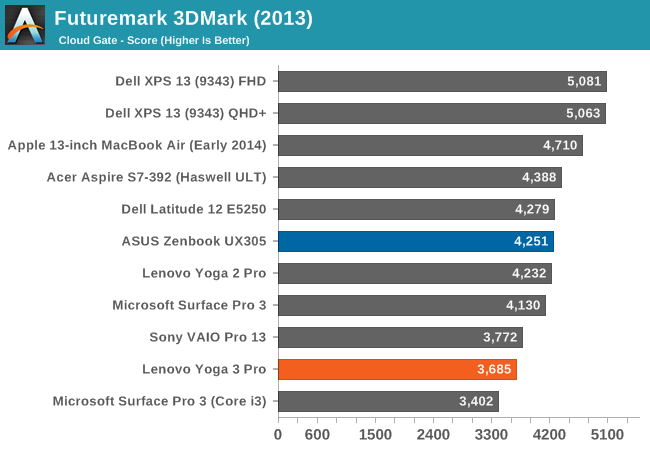
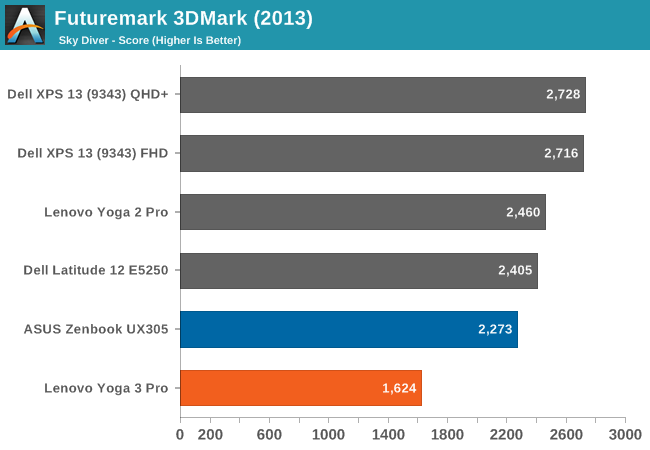

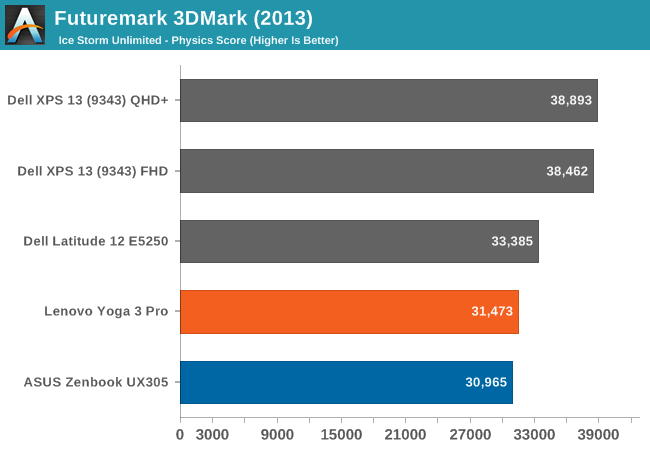
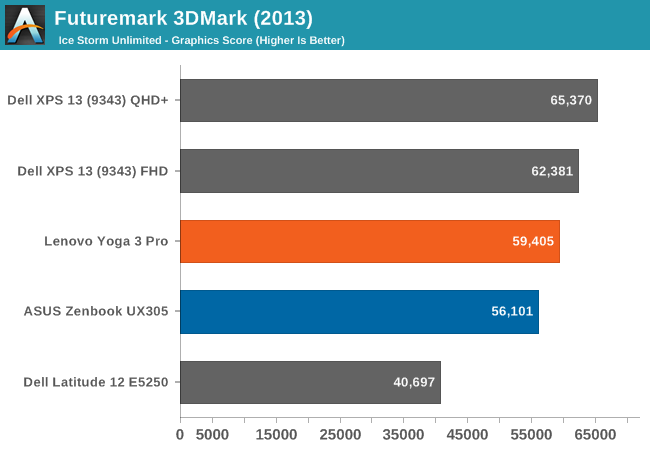
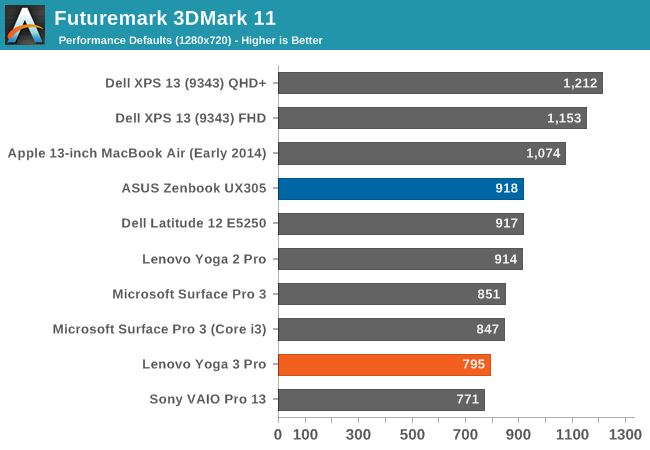
FutureMark has compiled several benchmarks in 3DMark 2013. All are a reasonable length, except for Ice Storm Unlimited which is more of a smartphone/tablet benchmark, and therefore completes very quickly on a PC. Here we can see how much more performance the ASUS UX305 can deliver over the Yoga 3 Pro, which again on paper has a faster processor. ASUS allows much more thermal headroom on the SoC, which results in considerably better scores when using the GPU. The exception to this is the Ice Storm Unlimited, which completes quick enough that the Yoga 3 Pro does not have to throttle as much.
GFXBench
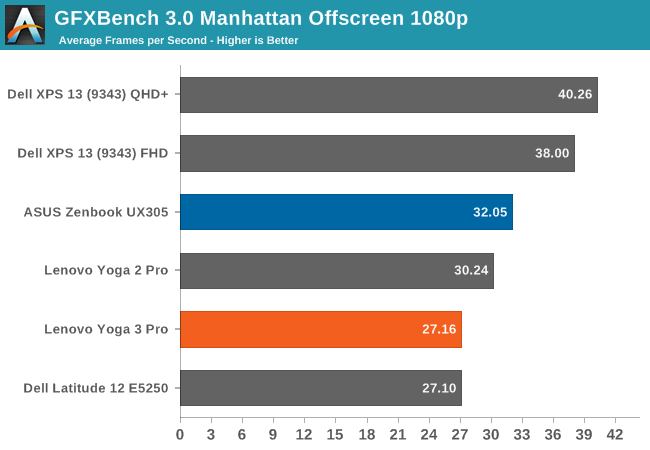
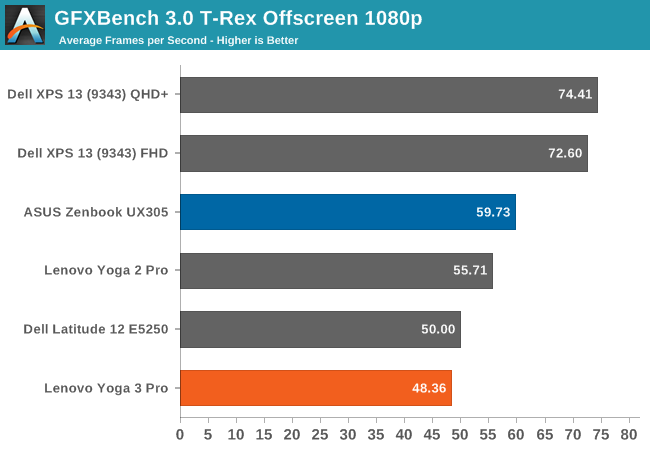
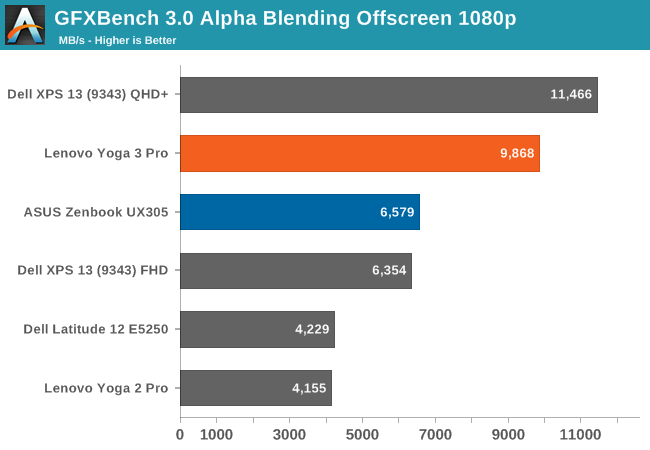
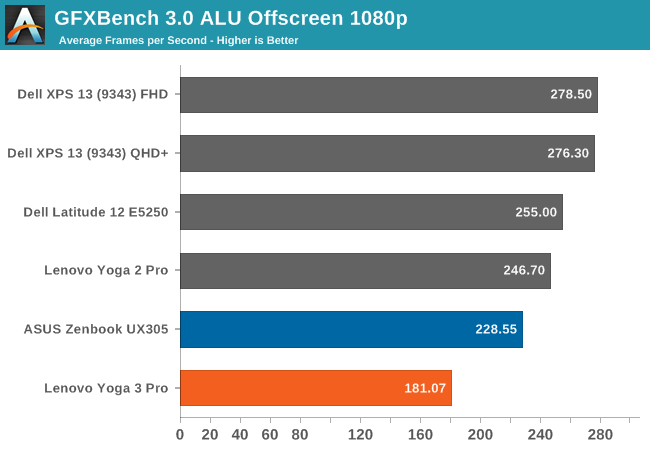
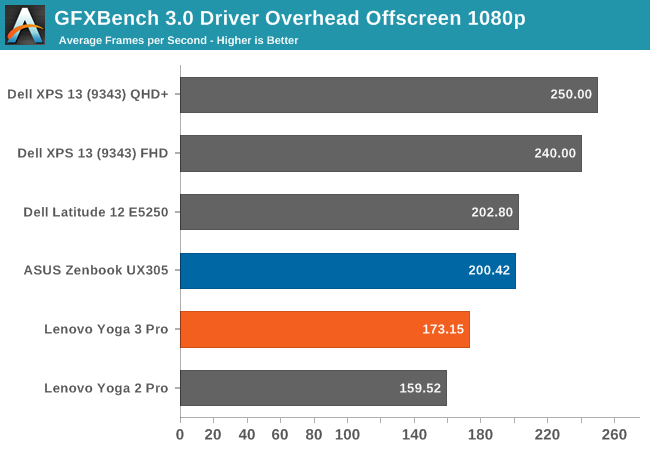
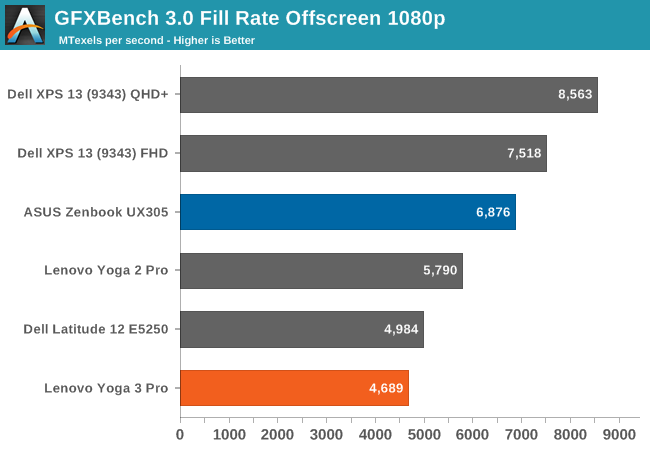
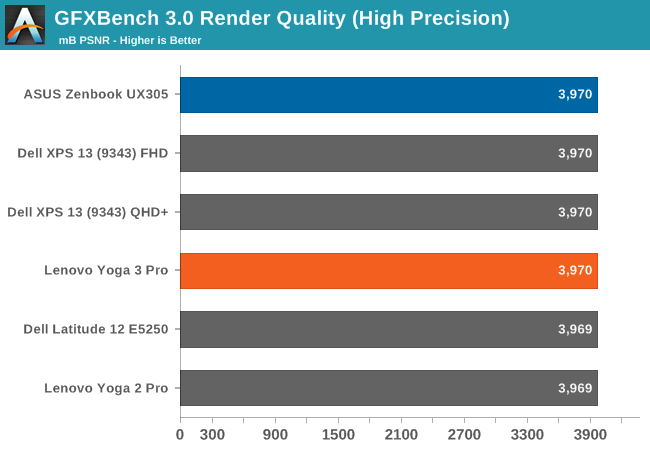
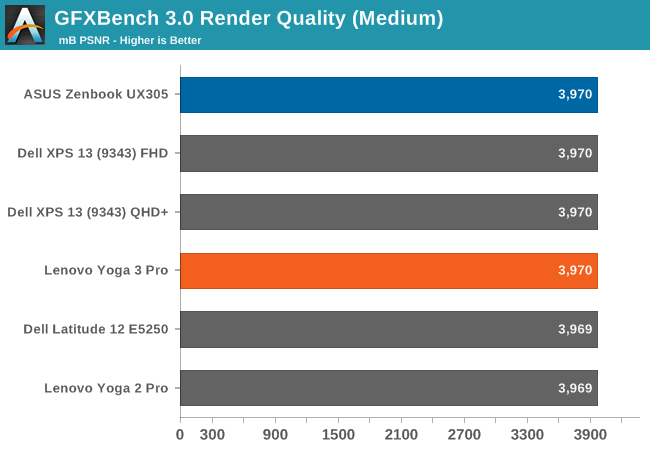
GFXBench 3.0 is available in the Windows Store, and is a DirectX version of GFXBench. On the two gaming benchmarks (Manhattan and T-Rex) we can see that the UX305 pulls ahead of both of the Haswell-U based devices in our graphs, which are the Yoga 2 Pro and the Latitude 12. The Dell XPS 13, with Broadwell-U, is still a lot more powerful which is not surprising since it has a 15 watt TDP compared to just 4.5 watts on Core M (Broadwell-Y). Once again, we can see that the ASUS is stronger than the Yoga 3 Pro.
DOTA 2 Benchmarks
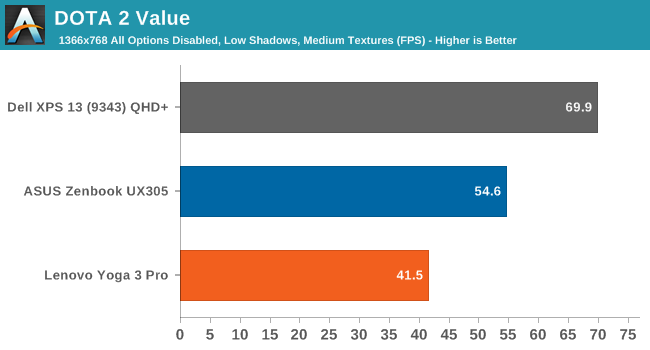
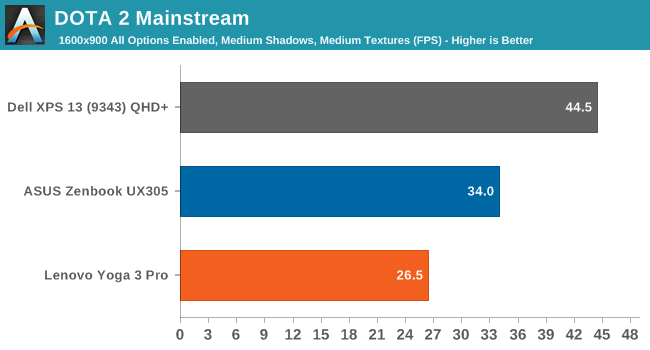
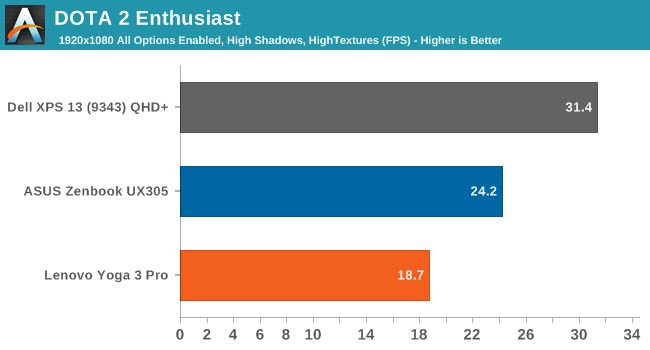
One area where the Yoga 3 Pro struggled was with our DOTA 2 benchmark, which is quite long in duration. We run at three different levels, and the Yoga 3 Pro fell quite far behind the Dell XPS 13. The ASUS UX305 closes that gap though, and gave a much higher frames per second than the Yoga 3 Pro.
Tablet Comparison
As with the Yoga 3 Pro, we will compare the ASUS UX305 to several tablets to see where Core M fits in the lineup. The UX305 is certainly not a tablet competitor unlike the Yoga 3 Pro, but the improved GPU performance seen in the laptop comparisons should give us some more information to about where the Intel graphics compare to the best SoC GPUs available today.
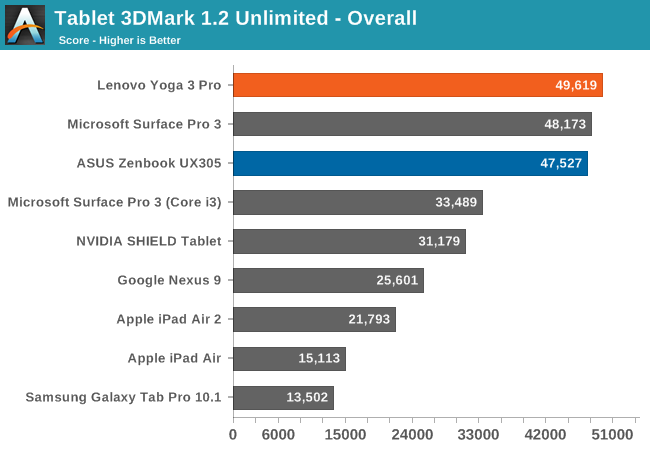
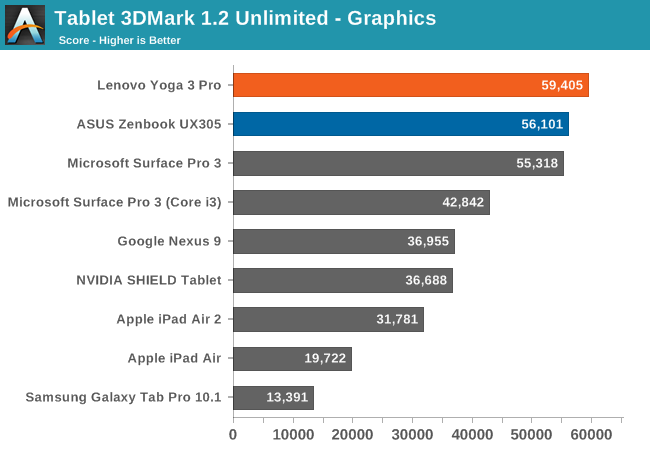

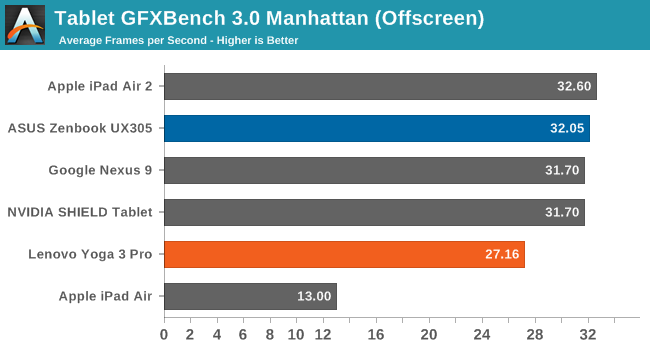
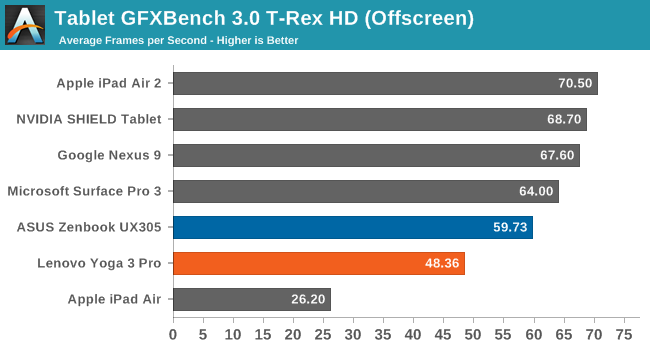


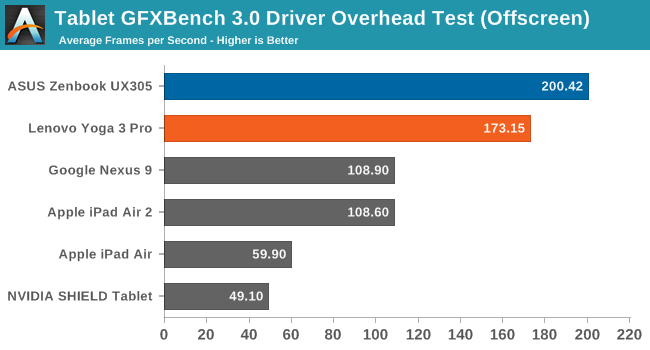
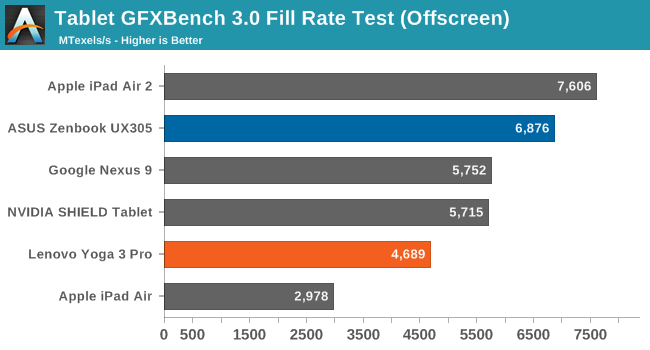
3DMark Unlimited shows the capabilities of the GPU, but is so short that the throttling issues we have observed do not come in to play. The Gen8 graphics of HD 5300 should certainly be able to compete favorably to any of the tablet SoCs if give enough headroom, however that is obviously not the case.
The GFXBench scores show that the Core M 5Y10 can compete with tablets, with it coming in very close to the same scores as all of the latest tablets on the Manhattan score. The T-Rex benchmark is much easier, and it falls behind a bit, but is still a lot quicker than the Yoga 3 Pro.
GPU Conclusion
The increased thermal headroom that ASUS allows on the UX305 has dramatically increased the GPU performance of Core M when compared to the Yoga 3 Pro. The device does get warm though, with it hitting close to 50°C at the top of the laptop, but it does not affect the keyboard or wrist areas. The lack of a fan makes these scores even more surprising, but Lenovo has opted to keep the surface temperatures a lot lower on the Yoga 3 Pro.
There is a lot to be said about Core M performance, and too much to put in this review. We will be doing a deeper dive into the performance of Core M and how it performs in various devices, both actively and passively cooled, as well as compared to Broadwell-U based systems which are a more traditional design. Clearly, there is a lot of factors that affect performance in a device such as this than just the label on the spec sheet.


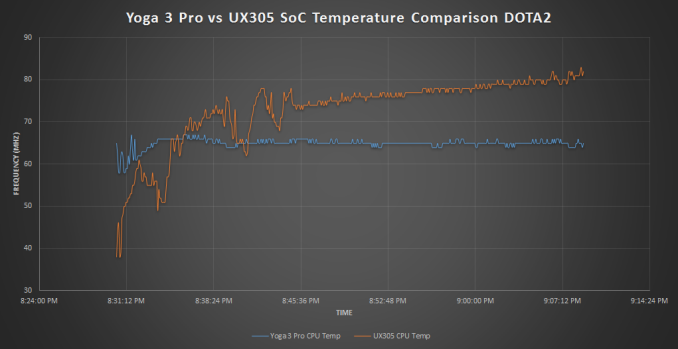








164 Comments
View All Comments
Ratman6161 - Friday, March 27, 2015 - link
The core M's are specifically intended for the low power market so if performance is your priority you wouldn't be looking at this one in the first place. You would instead be looking at the new generation of i3, i5 etc just coming out:http://ark.intel.com/products/family/84981/5th-Gen...
http://ark.intel.com/products/family/84980/5th-Gen...
Refuge - Wednesday, March 25, 2015 - link
Yea Intel has been making leaps and bouns the last couple of years in their processors. But none of it has been tailored towards power users or high power markets.It has all been in increasing efficiency, which they have done an amazing job of catching up in. But the downside of all this is that for 2-3 years all us power/high power users to sit with our thumbs up our asses while we wait for something worth our while to come out.
If you aren't super concerned with lowering TDP to save power then you are just going to have to wait a bit longer before Intel tries going back to their old ways. But then again, I'm not sure it will ever be the same again.
Once you go mobile, you stay mobile. :P
WithoutWeakness - Wednesday, March 25, 2015 - link
I'm still waiting for a compelling reason to upgrade from my i7-2600K. I've upgraded everything in my PC over the last 4 years with the exception of my Z68 motherboard and my CPU. The Sandy Bridge architecture has certainly stood the test of time.warezme - Wednesday, March 25, 2015 - link
This is apples to oranges but my prior laptop was a big heavy Alienware M17X M3 which I still have but I was tempted with the latest tiny, thin and extremely high performance 14" Razer Blade laptop which I don't think is much bigger than this Zenbook if that. But it sports a full Quadcore i7 4720HQ with hyperthreading and an Nvidia Maxwell GTX970M GPU. It is a killer combo with the 3200x1800 screen. It is so small compared to the Alienware and more than twice as fast.kingpotnoodle - Wednesday, March 25, 2015 - link
Performance wise it might not be any quicker but will probably be a huge upgrade to form factor and battery life, it really depends on your priorities. If the laptop never leaves the coffee table then no reason to get a thin and light design.FlushedBubblyJock - Wednesday, March 25, 2015 - link
I don't know if I can agree with that. No matter the coffee table the couch is very nearby, thus kicking back on that or the easy chair - not to mention the backyard picnic, watching something while ironing in the laundry room - setting it about for TV/movies/netflix/news in the kitchen.I think it would be great for a home only user.
kingpotnoodle - Thursday, March 26, 2015 - link
I don't wish to be pedantic, but your scenarios are "leaving the coffee table", perhaps I should have said desk. I've met people with laptops who almost never pick it up, they just got it because a desktop takes up too much space and doesn't fold down.jramskov - Wednesday, March 25, 2015 - link
You do get a much snappier machine due to the SSD and it's got a generous (for the price) amount of memory.FlushedBubblyJock - Wednesday, March 25, 2015 - link
The Dell XPS13 kept winning - I have to go hunt down the review on that, here, hopefully.Getting the QHD+ touchscreen on the Dell is twice the cost, but man, those benches.
Gigaplex - Wednesday, March 25, 2015 - link
That webcam angle...